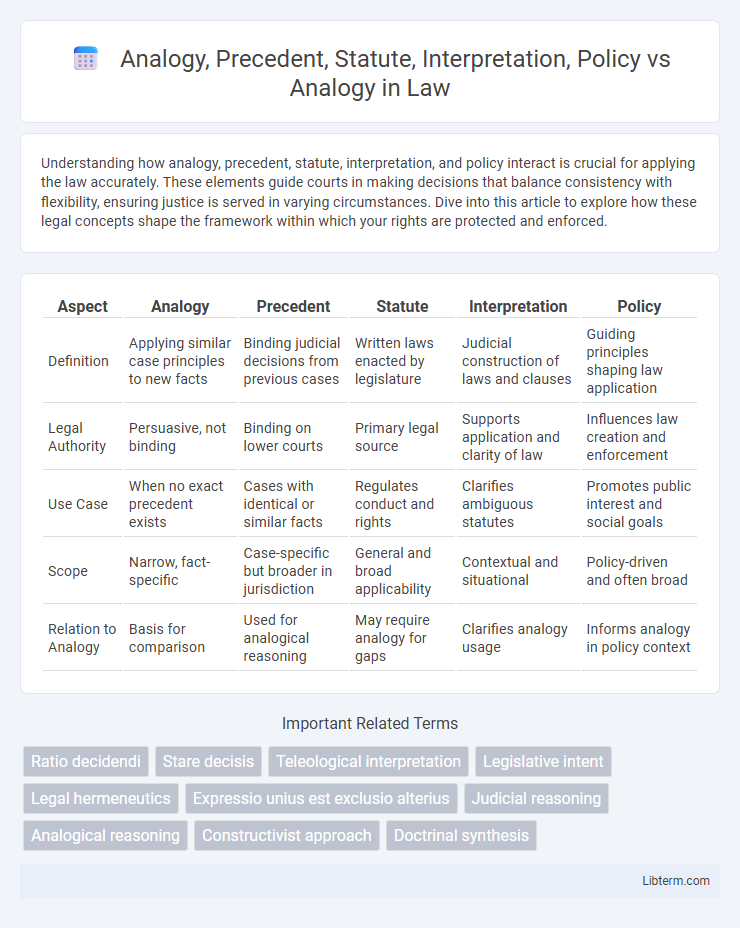Understanding how analogy, precedent, statute, interpretation, and policy interact is crucial for applying the law accurately. These elements guide courts in making decisions that balance consistency with flexibility, ensuring justice is served in varying circumstances. Dive into this article to explore how these legal concepts shape the framework within which your rights are protected and enforced.
Table of Comparison
| Aspect | Analogy | Precedent | Statute | Interpretation | Policy |
|---|---|---|---|---|---|
| Definition | Applying similar case principles to new facts | Binding judicial decisions from previous cases | Written laws enacted by legislature | Judicial construction of laws and clauses | Guiding principles shaping law application |
| Legal Authority | Persuasive, not binding | Binding on lower courts | Primary legal source | Supports application and clarity of law | Influences law creation and enforcement |
| Use Case | When no exact precedent exists | Cases with identical or similar facts | Regulates conduct and rights | Clarifies ambiguous statutes | Promotes public interest and social goals |
| Scope | Narrow, fact-specific | Case-specific but broader in jurisdiction | General and broad applicability | Contextual and situational | Policy-driven and often broad |
| Relation to Analogy | Basis for comparison | Used for analogical reasoning | May require analogy for gaps | Clarifies analogy usage | Informs analogy in policy context |
Understanding Analogy in Legal Reasoning
Understanding analogy in legal reasoning involves applying established precedents to new cases with similar facts or legal principles, enabling consistent judicial decisions. Unlike statutes, which are explicit laws enacted by legislatures, analogy relies on interpreting prior judicial decisions to fill gaps or address unforeseen issues. Policy considerations shape when courts favor analogies to promote fairness and societal values, distinguishing them from rigid statutory application.
The Role of Precedent in Judicial Decision-Making
Precedent plays a critical role in judicial decision-making by providing courts with established legal principles derived from prior rulings, ensuring consistency and predictability in law interpretation. Unlike analogy, which draws comparisons between similar cases, precedent relies on binding authority from higher courts within the same jurisdiction to guide decisions. Statutes and judicial policy influence the framework within which precedents operate, but the interpretation of precedent remains central to upholding legal stability and fairness.
Statutes: Foundation of Written Law
Statutes serve as the foundation of written law, providing explicit legal rules enacted by legislative bodies. Interpretation of statutes involves analyzing language, context, and legislative intent to apply the law accurately, contrasting with analogy, which extends legal principles to similar, but not identical cases. Unlike policy considerations that guide lawmaking and judicial decisions, statutes offer concrete legal authority grounded in codified legislation and established precedents.
Techniques of Legal Interpretation
Techniques of legal interpretation include analogy, precedent, and statutory analysis, each playing a distinct role in judicial reasoning. Analogy draws parallels between similar cases to fill gaps where statutes are silent, while precedent relies on previous judicial decisions to guide current rulings, ensuring consistency in the law. Statutory interpretation focuses on the literal meaning of legislative texts, balancing intent and purpose, whereas policy-based interpretation considers broader social objectives but must be cautiously applied to avoid undermining established analogical arguments.
The Interplay Between Policy and Analogy
The interplay between policy and analogy is pivotal in legal reasoning, where policy guides the purpose behind laws while analogy ensures consistency by applying established legal principles to new cases. Statutes provide the written framework, and interpretation bridges the gap between rigid statutory text and dynamic application, often relying on precedent to shape outcomes. Understanding this balance enables courts to maintain legal stability while adapting to evolving societal needs through nuanced decision-making.
Comparing Precedent and Analogy in Law
Precedent refers to past judicial decisions that establish legal principles applied in similar future cases, ensuring consistency in law. Analogy involves reasoning from established cases with similar facts or principles to decide new cases lacking direct precedent, offering flexibility in legal interpretation. While precedent provides a binding framework, analogy allows courts to extend legal reasoning to novel situations, balancing certainty with adaptability.
Statutory Interpretation and its Impact on Case Outcomes
Statutory interpretation plays a critical role in determining case outcomes by guiding judges in applying legislative intent to specific legal disputes. Courts rely on precedent and analogy to interpret ambiguous statutes, ensuring consistency and fairness while balancing policy considerations that may influence the scope or application of the law. Effective statutory interpretation helps clarify legal standards, reduces uncertainty, and shapes the practical enforcement of statutes within judicial decision-making.
Advantages and Limitations of Legal Analogy
Legal analogy enables courts to apply established principles from previous cases to new, similar cases, promoting consistency and predictability in statutory interpretation. It facilitates the adaptation of law to novel situations where statutes may be silent or ambiguous, filling gaps through reasoned comparison. However, reliance on analogy may limit legal development by perpetuating outdated precedents and may lead to arbitrary or inconsistent outcomes if dissimilarities between cases are overlooked.
Policy Considerations versus Analogical Reasoning
Policy considerations prioritize practical outcomes and societal impacts when shaping legal rules, emphasizing the broader purpose behind laws. Analogical reasoning relies on comparing facts and legal principles from prior cases (precedents) to apply established rules consistently. Balancing policy versus analogy requires integrating the explicit goals of legislation and social benefits with coherent, precedent-based legal interpretation to achieve just decisions.
Balancing Statutory Text, Precedent, and Interpretation in Legal Analysis
Balancing statutory text, precedent, and interpretation in legal analysis requires harmonizing explicit legislative language with established judicial decisions and evolving interpretive methods. Statutes provide concrete legal standards, while precedent ensures consistency and reliability in application, and interpretation adapts these elements to contemporary contexts. Distinguishing policy considerations from analogy emphasizes the grounded authority of statutes and precedent over subjective judgments in judicial reasoning.
Analogy, Precedent, Statute, Interpretation, Policy Infographic

 libterm.com
libterm.com